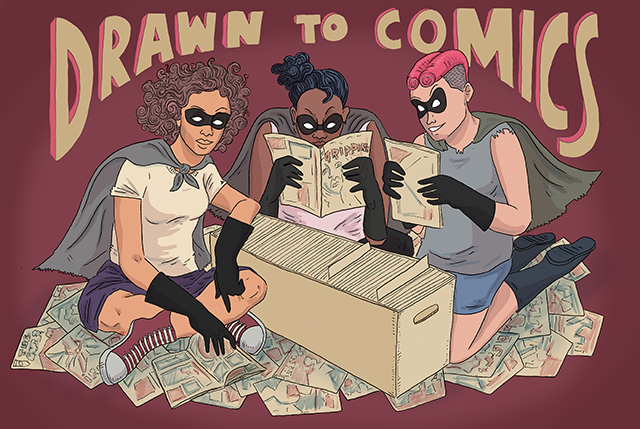
by rory midhani
It’s Trans Awareness Week, the week leading up to Trans Day of Remembrance on November 20th. When we say that Autostraddle is website primarily for queer women, we want to be 100% clear that that includes queer trans women and that it’s important to honor trans women year-round, not just in obituaries. So all week long we’re going to be spotlighting articles by and about trans women, with a special focus on trans women of color. We hope you’ll love reading everything as much as we’ve loved writing and editing it.
I’ve been reading comics ever since I was in elementary school, when I would go to the public library and run upstairs to the comic section and check out whatever graphic novels they had, even if I had read them a dozen times before. But it wasn’t until I was a teenager that I saw my first trans character in a comic book. Like many people, my first experience with a trans comic character was in Neil Gaiman’s Sandman. I remember when I was in high school opening up Volume 2, titled The Doll’s House, and reading issue #14, Collectors. This issue focuses on a serial killer’s convention and predictably features some extremely disturbing content. The thing that stuck in my mind, though, is one panel where we see a killer standing over a dead trans woman with narration that says “There’s something about preoperative transsexuals that makes The Connoisseur uncomfortable. Something brittle and bright in the back of their eyes. He loves them. But he always feels they’re laughing at him. He’s only ever found eight that he’s been able to talk to.” This was my first time seeing someone like me in a comic book. It made me terrified for my future.
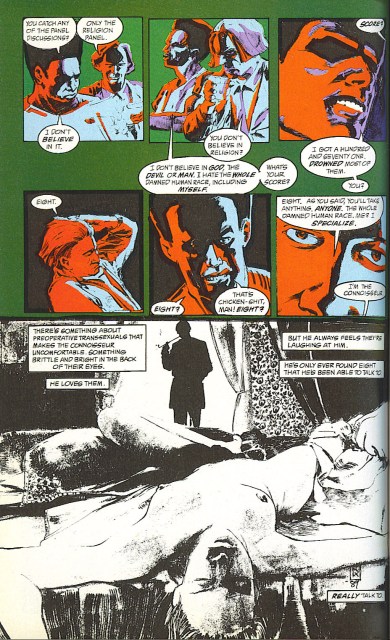
From Sandman #14.
One of the big selling points of comic books is that they give us heroes to look up to and want to be like. They show us possibilities. They show us dreams and wishes. Not being able to see yourself in those dreams, wishes and possibilities can really have an effect on you, especially if you’re a younger reader. When readers are told that none of the heroes look like them, it can seem like it’s impossible to be a hero. That’s why representation is important. It allows us to see a brighter future for ourselves and to set out for that future. For trans readers, that representation has been almost nonexistent until recent years.
The Era of Not-Quite-Trans Characters (1940-?)
Unfortunately, transgender people are a group that was so marginalized in comics that the only characters trans people could see ourselves in were shapeshifters, aliens and victims of magic spells or science fiction body swaps. While trans characters were scant for most of the history of comic books, these kinds of characters were actually pretty popular, going as far back as DC Comics’ Golden Age. So while these characters are not quite trans, they still served an important function in giving trans readers some semblance of representation in their comics.

The Ultra-Humanite in Action Comics #20 with art by Joe Shuster.
One of the earliest examples of a not-quite-trans recurring character took place in Action Comics #20 from 1940. The Superman villain, Ultra-Humanite (a super genius similar to Lex Luther), has seemingly been killed. However, we learn that he had kidnapped a famous actress, Dolores Winters, and placed “his mighty brain in her young vital body.” As soon as Action Comics #22 this version of the Ultra-Humanite was gone and later instead of putting his mind in the body of a woman, the character would transfer his consciousness into the body of an albino ape. However, during the events of Infinite Crisis, a universe-wide crossover event in the late 2000’s, and in the 2006-2007 Lightning Saga crossover event, the Ultra-Humanite’s time as Dolores (now spelled Deloris) Winters is revisited.

Sir Tristan in Camelot 3000 with art by Brian Bolland.
The next notable examples appear in the 1980s when DC Comics published Mike W. Barr and Brian Bolland’s sci-fi/fantasy series Camelot 3000. In this story King Arthur and his knights of The Round Table are reincarnated in the year 3000 in order to fight off Morgan le Fay and an alien invasion. One of the knights, Sir Tristan, is reincarnated as a woman. Tristan spends much of the comic trying to figure out a way to be turned back into a man, but in the end accepts this new body and role, even ending up with Isolde, Tristan’s lover throughout time. Stories like this showed the lack of awareness of real life trans people that comics had. Sir Tristan could have been portrayed as a trans man, and in the 80s there were ways for trans men to transition, so one would think that a thousand years in the future, those techniques would be much better. Marvel, for their part, in Alpha Flight #45 from 1987, had their own mind-transfer story. The Canadian superhero Sasquatch, who was basically a man who could turn into a giant white beast, was “killed” and his soul was transferred into the body of another Canadian superhero, a woman named Snowbird. So for a time Sasquatch had a “female” body when in human form and the male, Sasquatch form.
This trend really reached its peak in the 1990s. We saw characters like Malibu Comics’ Mantra, who had her own solo title, an immortal male superhero soul who was reincarnated into the body of a woman; Top Cow’s Joshua Cane, a character from the series Rising Stars who was possibly trans and had as one of their powers the ability to turn into a super-powered woman and DC’s Comet, who appeared in Supergirl comics and, in 1997, was revealed to be a shapeshifter who alternated between being the bisexual human woman Andrea Martinez and the male centaur Comet all reflected this trend of comics playing around with gender, but not actually having trans characters.
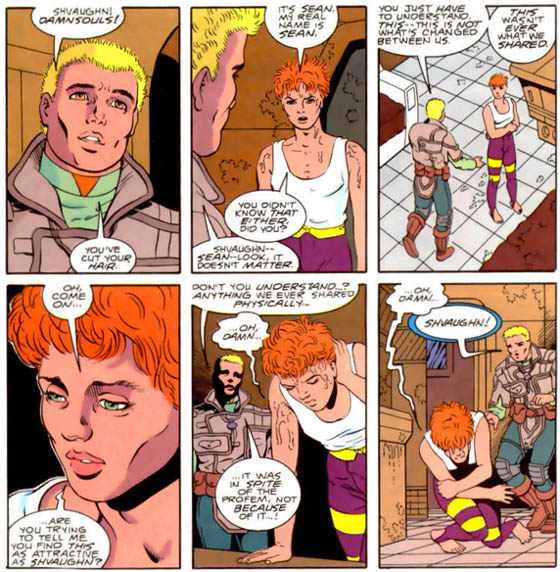
From Legion of Super-Heroes #31.
One of the characters who comes closest to actually being trans is Shvaughn Erin, a member of the interplanetary Science Police in the DC comic Legion of Super-Heroes. Erin was actually introduced as a female character in 1978, but in 1992, in Legion of Super-Heroes #31, it was revealed that Shvaughn was actually Sean, and that he was born male, but had been taking a futuristic drug called Profem in order to transition into a female form apparently because he was in love with the male superhero Element Lad, who he presumed was straight, but actually turned out to be attracted to Sean just as much as Shvaughn. Again, the lack of knowledge about trans characters shows here, as the Legion writers not only had to use a science fiction drug, Profem, that would cause its user to revert back to their original form once they stopped taking it, but they also seemed to think that trans women are just gay men who want to date straight men.
This “era” actually stretches all the way to recent comics of the 2000s. In 2000, Marvel had two characters who fit into this category. In their Ultimate Universe, the character of Spider-Woman, Jessica Drew, is actually a female clone of Peter Parker who retains some of his memories and has some struggles with her gender as a result, and in their X-Men comics, Courier, a shapeshifting friend of Gambit, became trapped in a female form by the evil Mr. Sinister. Over at DC in the year 2006, the character Erik Storn was given superpowers which manifested in him becoming a female superhero named Amazing Woman. In 2008, the longtime Thor villain, Loki, had taken over a female body (that of Lady Sif) and was portrayed as a woman until Thor #602 in 2009. Loki could possibly go on this list again, as when a younger version of the character got his own title, Loki: Agent of Asgard, in 2013, Al Ewing, the series’ writer said that “Loki is bi and I’ll be touching on that. He’ll shift between genders occasionally as well.” So, Loki could possibly count as transgender, as much as a shapeshifting trickster god can be.
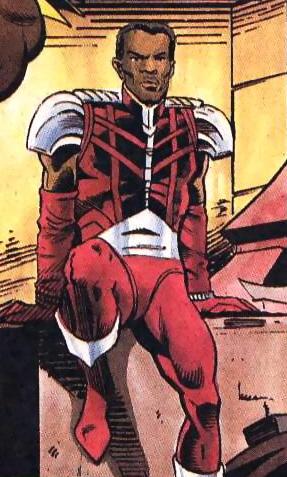
Masquerade in Blood Syndicate #1 with art by Trevor Von Eeden.
A couple of these characters actually might be better suited in other categories, but I’m going to mention them here first. In 1993, Milestone Comics introduced the character Masquerade, a shapeshifter who was a male superhero, but was assigned female at birth. Finally, this conversation wouldn’t be complete without a mention of Xavin, a shapeshifting Skrull from Marvel’s comic about the teenage children of supervillains, Runaways. While Xavin initially shows up as an ostensibly male character, they change to a female form saying “for us changing our gender is no different than changing our hair color” in issue #8 of the series. While this attitude toward gender and ability to shapeshift make Xavin not really representative of the human transgender experience, the character did explore changing gender in a way that was pretty revolutionary for a comic book character.
Next: Actual trans women characters!
Trans Women at DC in the Early 90’s (1992-1994)
With the 90s came the rise of alternative comics at DC. While mainstream comics stayed far away from actual trans characters, sticking to their shapeshifters, five titles, all at DC or DC imprints, actually gave pretty substantial roles to trans characters.
The most famous of these trans characters is probably Wanda in the previously mentioned Sandman series. After we see the murdered and unnamed trans woman in The Doll’s House, we meet Wanda in A Game of You. Wanda is one of the people living in an apartment building with the book’s main character, Barbie. She’s Barbie’s best friend and is in a pretty substantial amount of the book. However, Barbie soon becomes trapped in Dream land and when it comes time to rescue her, Wanda is left behind. The witch Thessaly takes two other women from the apartment building, Hazel and Foxglove, with her, but leaves Wanda behind because, as she’s told by the disembodied face of a man named George in Sandman #35, “It’s because you’re a man. That stuff they did with the uh moon, that was a woman thing.” When Wanda demands recognition that she’s a woman, when she says, “Listen: I’ve had electrolysis. I’m taking hormones. All that’s left is just a little lump of flesh; but all that doesn’t matter. Inside I’m a woman,” George replies “She (the moon) doesn’t seem to think so. And to be honest uh well even if you had uh had the operation it wouldn’t make much difference to the moon. It’s chromosomes as much as uh anything. It’s like uh gender isn’t something you can pick and choose as uh far as gods are concerned.”
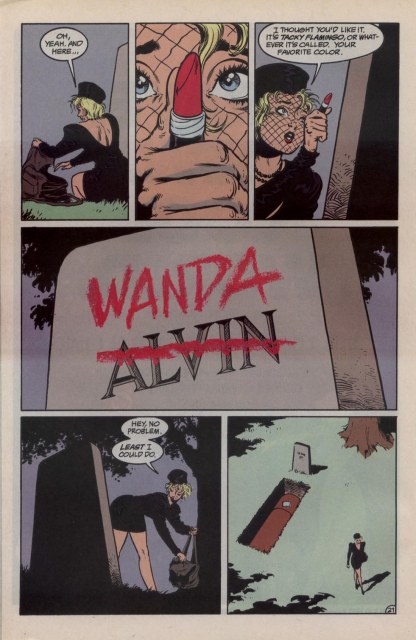
From Sandman #37 with art by Shawn McManus.
Wanda says that the gods can take that and stuff it up “their sacred recta,” but it still remains that even in this world of fantasy, where we have gods and demons and witches, the supernatural forces that govern the universe are, for some reason, stuck on the Western gender binary. A little later in the series Wanda is killed when a storm collapses the apartment building, and her transphobic parents bury her as a man. Barbie then comes by and crosses off the name on her tombstone and writes “Wanda” in red lipstick. Wanda does stand out as one earliest and best examples of an actual trans person in comics, but she also gives many trans readers mixed feelings. Not only does she die a tragic death, as far too many real life trans people do, but she’s also misgendered, by the moon of all things. Trans people can’t even be acknowledged as real women by the gods in fantasy comics.
I mentioned Masquerade earlier, but I want to revisit him here. While it’s true that he was a shapeshifter, and that’s how he transitioned, it does appear that actually was a trans man, making him the first trans man superhero. He was a character in the comic book for the superhero group Blood Syndicate, which was written by Dwayne McDuffie and Ivan Valez, Jr. and was made up of mostly African-American and Latino characters. While another character, Fade, eventually does find out about Masquerade’s gender assigned at birth in Blood Syndicate #10, it seems that he works as a male superhero because that is his idealized version of himself. Also in Milestone comics at the same time as Masquerade was a character named Marisa Rahm. She was in the series Deathwish and was a police Lieutenant and trans woman in a relationship with another trans woman, a sex worker named Dini. Rahm is faced with disgust and discrimination when she starts to transition while a police officer; she eventually defeats a serial killer who is targeting trans women. Another notable thing about Deathwish, and therefore Rahm, is that the miniseries was written by Maddie Blaustein, a trans woman who also worked as a voice actor, perhaps most notably playing Meowth in the American version of the Pokemon cartoon.
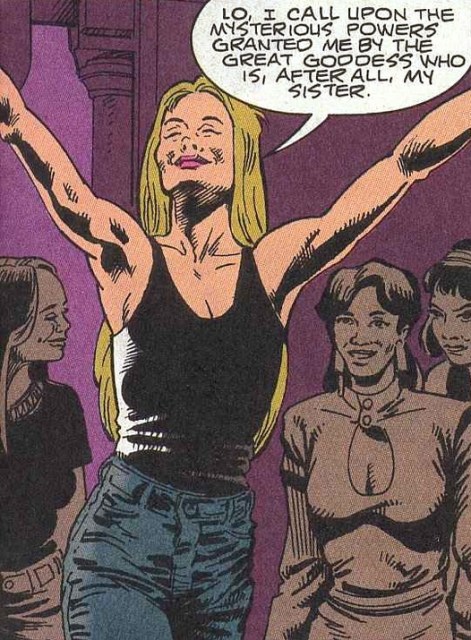
Kate Godwin in Doom Patrol.
Perhaps the biggest marker that real progress was being made in the area of trans representation in comics was the case of Kate Godwin, or Coagula in 1993. Coagula was a member of DC Comic’s off-beat superhero team Doom Patrol, and was not only a trans woman, but was also created and written by a trans woman, Rachel Pollack. She had the power to coagulate and dissolve liquids at will (hence the name) and was bisexual, eventually entering into a relationship with her Doom Patrol teammate, Robotman, who is a human brain in the body of a robot. I talked to Pollack about where her idea for Kate Godwin came from, and how she created the character. She said that she wanted to see someone like her in the comics she loved.
To a large extent I was inspired to write Doom Patrol by the previous writer, Grant Morrison, whose run was brilliant and daring. Morrison had a thing, apparently, for transvestites and drag queens (some variation appeared in almost all his comics at that time), so it seemed an almost obvious step to have an actual trans character. More importantly, this was during one of my trans activist periods, so I was very involved in trans issues. I gave Kate a history of being a [sex worker] and a computer programmer since at that time those were by far the professions most represented in trans women’s lives. Interestingly, the name “Coagula” appears exactly once in the comic, in her story about applying to the Justice League. Other than that, it’s always just Kate (in honor of Kate Bornstein — the Godwin was inspired by my friend Chelsea Goodwin saying she’d always wanted to be a character in a comic — plus Mary Godwin, the maiden name of Mary Shelley, author of Frankenstein, whose mother Mary Wollstonecraft wrote Vindication of the Rights of Women).
I just realized an interesting, and convoluted, connection. At that time, so-called radical feminists were fond of describing people like us as “Frankenstein’s monsters,” men changed into pseudo-women by male doctors to infiltrate the women’s movement and destroy it with their evil male energy. Seriously. I am not making this up. I wish I was.
Pollack said that being able to introduce a trans character like Godwin felt wonderful, “not just because of the external fact of creating a trans woman hero, but also because she made the whole team coalesce, she brought together the story and its implicit themes — body issues and extreme outsiders learning to accept themselves and embrace life.”
Funnily enough, a year after he left the title and Pollack wrote Kate Godwin into Doom Patrol, Morrison introduced his own trans woman character, Lord Fanny, into his Vertigo series The Invisibles. Fanny was a shaman in Brazil, who was assigned male at birth, but was raised as a girl by her grandmother, who wanted her lineage of (female only) witches to continue. She was, confusingly enough, a shaman for an Aztec goddess, despite being from Brazil and not Mexico. Lord Fanny could also potentially belong in the Not-Quite-Trans category, as she was forced to be a girl by her grandmother. Outside of DC, Guy Davis and Gary Reed’s Baker Street, a punk rock take on Sherlock Holmes released by Caliber Comics had a character named Sam who was revealed to be trans in its second volume.
The Beginning of the Change (2005-2013)
Trans representation in comics fell pretty dormant for around a decade. As Pollack told me, this was probably “because the general society just wasn’t ready — not just ready to accept us as real, but even just to see that we exist.” After the spate of trans women appearing in comics in the early nineties, the next significant trans character was perhaps not really trans at all.
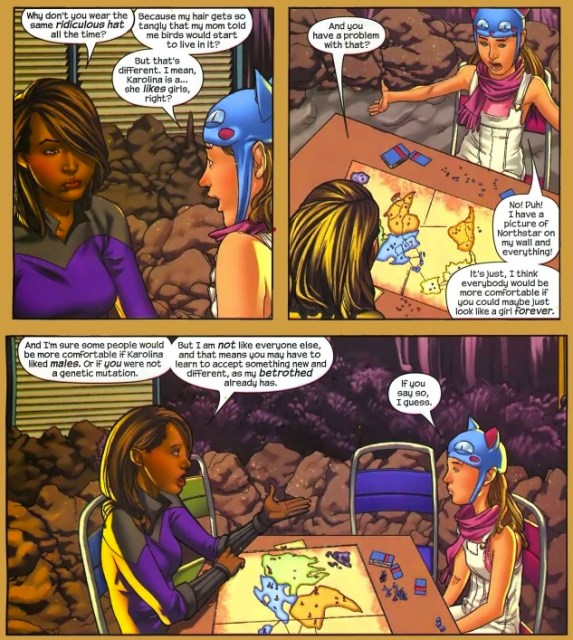
Xavin and Molly having a discussion about gender in Runaways #22 with art by Adrian Alphona.
Xavin, as I mentioned earlier, was a shapeshifting Skrull who alternated between presenting as male and female and who made her debut in Brian K. Vaughan’s series Runaways in 2005. She was usually in her female form when with Karolina Dean, a lesbian character who Xavin was sent to earth to marry in order to end a galactic war. While she spends perhaps the majority of her time in the series in her male form, several times she indicates that she feels more female. When she and Karolina are getting married, she tells her “I’m only a groom for my fellow Skrulls; Karolina, deep down I’m a blushing bride like you.” There’s also a scene in Volumen 8 of the series where she and Karolina are arguing, causing Xavin to lose control of herself and she unconsciously shapeshifts into her “female” form, causing Karolina and Molly, another member of the team, to be excited that Xavin’s female form is her default. A confused and somewhat defeated Xavin replies, “I didn’t realize that was in doubt.” Ultimately, I think the most reasonable reading of Xavin is as genderfluid.
In Morrison’s 2005 DC series Seven Soldiers, he took the character Shining Knight, who had previously been a cis man, and remade him into a woman named Ystina who disguised herself as a man in order to fight as a knight. The 2011 fantasy series Demon Knights, written by Paul Cornell, takes this another step closer to actual trans and intersex representation. In Demon Knights #14, in 2012, Shining Knight has a conversation with Exoristos, a woman with ties to the Amazons who has feelings for him, and says “I think you like one… aspect of who I am. But I’m the other too. I was born this way. I’ve kept saying, whenever anyone asks. I’m not just a man or a woman. I’m both.” While Cornell was initially reluctant to label Sir Ystin, he later tweeted “It’s great that a DC character can come out as transgender and it not excite much comment. Very refreshing.” It’s still not clear, though, if this means Sir Ystin is a trans man, bigender, intersex or some combination of those identities.
Then, on April 10, 2013, in Batgirl #19, probably the biggest moment in American trans comics history happened. Alysia Yeoh, Batgirl’s bisexual, Singaporean-American activist roommate came out as trans.
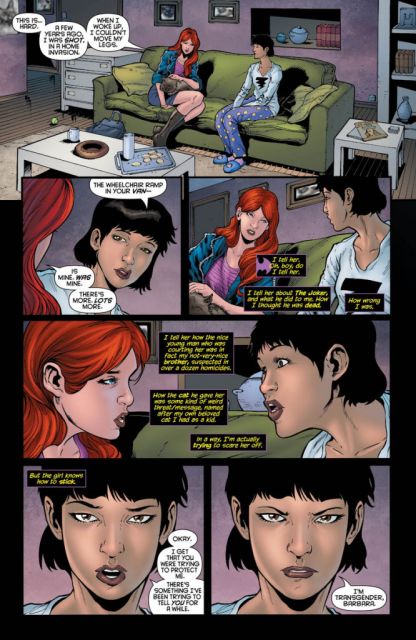
Alysia coming out to Barbara Gordon from Batgirl #19.
Before this Alysia had been a big part of Barbara’s life, and was, at that time, probably her closest friend. The two were having a conversation where Alysia told Barbara that she was worried about her, and so Babs tells her that she used to be paralyzed, that she was shot by The Joker, that her brother is a serial killer. Alysia responds to Barbara’s sharing of these intimate secrets by sharing her own. In one of the most touching moments in comics that year, Barbara hugs Alysia and tells her to call her “Babs,” saying “The people I love call me Babs.”
This moment marked the first time we saw a non-fantasy, non-science fiction, human trans character in a non-mature, mainstream comic book. At the time, Batgirl was DC’s 17th highest-selling title, this was a big moment. It was the big moment trans readers had been waiting for. Then Batgirl writer and Alysia’s creator, Gail Simone told me that she created the character because, as a woman, she knows what it’s like to look for characters you can relate to and not be able to find them.
When I was a little girl, there was literally no one who supported the fact that I read comics. I mean, there was no support system and my few interactions with other comics readers were actually a bit hostile. That stuck with me. I always dreamed of a time when comics opened up and said, simply, “You are welcome here.”
So when I ended up writing comics, I made a concentrated effort to create fun new female characters, it was really important to me, because I knew there were a lot of little girls out there who would love this medium if given half a chance. But then I started going to conventions, and I realized the shallowness of my philosophy. Here we had this readership that was incredibly, remarkably divers…people of every age, gender, body type, sexuality, ethnicity and more, and it was very clear that comics hadn’t changed much in decades. Where were the characters that represented them?
She was also inspired by fans she met, trans readers who told her that they didn’t really have any heroes to look up to in their favorite comics.
Tokenism isn’t enough, we can’t have one character and say, “okay, good, we’re done, let’s move on.” I had met and spoken with so many trans readers, smart lovely people who loved comics, but had to appropriate characters that were, you know, robots or aliens in comics because that was the closest thing to any kind of trans representation. It bothered me a lot. I know there’s always a danger of allies jumping in and sucking all the oxygen away from the conversation, but it bothered me and I wanted to say that thing, “You are welcome here,” to everyone, not just little red-headed farm girls like I had been.
Simone initially thought that she was going to face pushback from her editors about introducing a trans character. After all, if it was so accepted, why weren’t other writers already introducing trans characters into their books?
So I got the help of some wonderfully brilliant and generous trans readers, and I made a lunch appointment to speak with my DC boss, Dan DiDio at San Diego. I was ready to fight for Alysia to be trans in Batgirl. It was important. I made a list of reasons why it should happen, and in a key book, a BAT book. So I came loaded for bear.
I give my pitch to Dan, expecting an argument. Instead, he pauses for a moment, and just says, “Okay, but I don’t want it to be exploitative. Make it honest.” And it really took the wind out of my sails, because I had this argument READY TO GO. But Dan has honestly always been great about LGBTQ characters, I needn’t have worried.
While DC Comics was supportive, others weren’t quite so happy about a trans character who was Batgirl’s best friend. Many readers, though, and especially trans readers, latched onto the character, who was already well-liked, and made her into a quick fan favorite.
We expected backlash. And there was some, I still get hate mail about it once in a while. A couple of late night talk show hosts lost my respect by making crappy jokes about it (fuck you, Conan O’Brien). But honestly, the truth of the matter is that the positive response was overwhelming, and completely overshadowed the angry weirdos. We got a ton of mail, almost all of it positive. And, I am happy to say that Alysia became by far the most popular character in the book, barring Batgirl herself. No matter how much room we gave her, people wanted more. When I left the book, Alysia was shuffled out of town off-panel to focus on a new cast, but the readers demanded her back. She’s that popular.
That made me very happy. And I again thank the many trans readers who helped me with important information and resources. Bless them all.
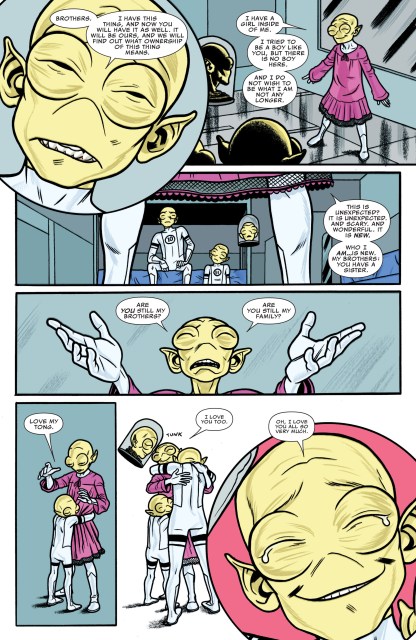
From FF #6 with art by Joe Quinones.
One lesser-known trans character that was introduced just two weeks after Alysia was in Matt Fraction and Mike Allred’s FF is a young Moloid named Tong. The Moloids are a subterranean race of humanoids who were originally created in 1964 by Stan Lee and Jack Kirby and four of them, including Tong, were members of the Future Foundation. This was a very strange book, and Tong isn’t technically human, but she is humanoid, and despite the somewhat odd way she talks, the way she came out as trans rings very true. In FF #6 she shows up wearing a pink dress and explains to her brothers, “Brothers. I have this thing, and now you will have it as well. It will be ours and we will find out what ownership of this thing means. I have a girl inside of me. I tried to be a boy like you, but there is no boy here. And I do not wish to be what I not any longer. This is unexpected? It is unexpected. And scary. And wonderful. It is new. Who I am… is new. My brothers: You have a sister. Are you still my brothers? Are you still my family?” The way Tong’s brothers embrace her and tell her that they love her, and the fact that she’s a child make this page amazingly touching. Later in the comic, Tong and is walking hand-in-hand with brothers wearing her new dress walk past the adults in charge of the Future Foundation. Ant-Man looks and says “Is that a thing we’re doing now?” while Miss Thing and She Hulk smile and respond “Good for her,” and “Okay.” Unfortunately, FF didn’t last much longer and Tong hasn’t really been seen since.
Next: Revolutionary representation from Image Comics
The Image Comics Revolution (2013-2015)
By 2014, Alysia and Tong were relegated to the bench over at DC and Marvel. DC even had a big misstep when a new creative team was brought on to Batgirl and we started seeing Alysia less and less. When she did show up again in Batgirl #37, her appearance was accompanied by a villain who reinforced a transmisogynistic trope. In this issue there’s a Batgirl imposter on the loose who turned out to be the male performance artist Dagger Type. While the idea of a trans villain isn’t in itself a problem (and while Dagger Type isn’t even trans), the way this story was handled was. Dagger Type’s initial portrayed helped to reinforce transmisogynistic tropes like “crazy crossdresser,” “creepy crossdresser” and “deceptive trans woman.” Even worse, when Barbara pulled off his mask and wig, she looked shocked and shouted “Dagger Type? But you’re a —.” While she was cut off by Dagger, it was clear that she was going to finish her exclamation with “man.” As I said when the issue first came out, “at this moment, Batgirl had no way of knowing Dagger Type’s gender. She’s seen one picture of him and an artist’s bio once and then she’s seen him dressed up as Batgirl multiple times. So she’s seen Dagger Type presenting as a woman way more than presenting as a man. Why does she assume he’s not trans? If you pull the wig off of someone who you thought was a woman, it is 100% transmisogynistic to yell in shocked horror that they are a man.” I do want to point out that this actually turned into a very good moment for trans comics, as the creative team of Cameron Stewart, Brenden Fletcher and Babs Tarr quickly apologized and promised to fix this problem and do better, which they did by changing the dialogue in the trade paperback and talking with several trans women about how to include better trans representation in this book and others.
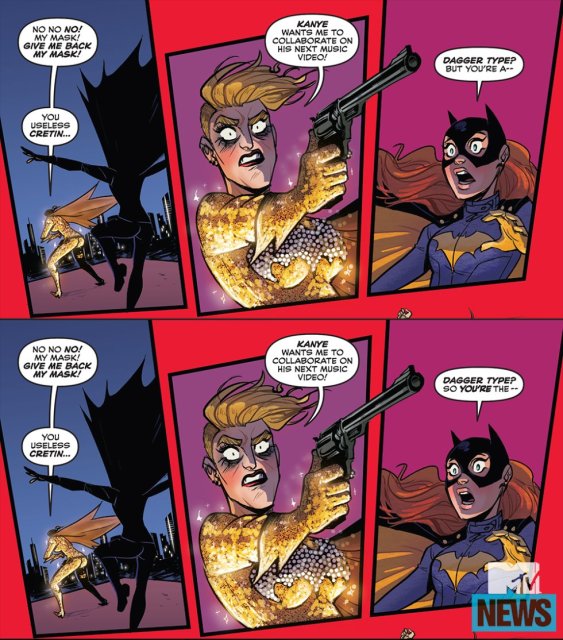
Some of the changed dialogue from Batgril #37 in the collected edition via MTV
Fortunately, while representation seemed to be slipping at DC and Marvel, another company quickly stepped in to become The Place to find quality trans representation in comics. Image, a company where creators retain the copyright to their own work, had been putting out award-winning comics by terrific writers and artists for years, so it made a lot of sense when some of these talented creators started including trans characters in their comics.
Already in May of 2013, Image started introducing trans characters into its comics. In Storm Dogs, by David Hine and Doug Braithwaite we meet a futuristic sex worker named Doll. While she is a “science fiction trans woman” in that she has a fully functional womb, something not possible for real trans women at this point, her depiction is still pretty realistic. In June of 2014, Joe Keatinge and Leila Del Duca’s series Shutter, an urban fantasy about the adventures of a semi-retired globally renowned explorer named Kate Kristopher, released its third issue, where we find out that Kate’s lifelong best friend Alain is a trans woman. While she’s not in a ton of the series, she still showed that a popular title at a popular publisher was willing to have a recurring character be trans. Similarly, Warren Ellis and Jason Howard’s series Trees introduced two trans characters in October of that year. In this science fiction series, the world has been covered in giant, tree-like aliens and we follow people’s lives in various cities affected by these “trees.” Trees #6, released in October of 2014, is about a man named Chenglei who meets and starts to fall for a woman named Zhen who tells him that she’s transgender and asks if he has a problem with that. While the writing is a little clunky, Chenglei realizes that he doesn’t have a problem with Zhen being trans and when he goes to his uncle for advice on life and love, he finds out that his uncle is actually a trans man. In January of 2015, another Image series, the punk rock D&D Rat Queens, written by Kurtis J. Wiebe, also revealed that one of it’s recurring characters, a fearsome orc warrior named Braga, is a trans woman in her own backstory issue, Rat Queens Special: Braga #1. When Tess Fowler took over as the artist for the book this summer, trans artist Tamra Bonvillain took over on coloring duties, making Rat Queens another book with both a trans character and a trans person on the creative team.

From The Wicked + The Divine #9 with art by Jamie McKelvie.
The most prominent example of trans representation in Image comics, though, comes from Kieron Gillen and Jamie McKelvie’s amazing The Wicked + The Divine. This series, which takes place in London, is about a group of gods who are reincarnated into the bodies of teenagers every 90 years only to live as the most celebrated of celebrities for two years and then die. The current group of gods, known as The Pantheon, features several queer characters, including one, Inanna, who is very gender non-conforming. Another character, Cassandra, is hinted at being a trans woman, and then is revealed to be one (in an apology for an earlier transphobic remark from the reincarnated Lucifer, no less) in The Wicked + The Divine #5, released in October, 2014. Later on, Cassandra, who is a journalist, biracial woman of English and Japanese descent, and one of The Pantheon’s biggest skeptics, is revealed to be the 12th member of The Pantheon, Urdr. Cassandra/Urdr is not only a well-fleshed-out character, but also one who features heavily in the book. The way the book handles her being trans, and other people’s transphobia, is also one of the best portrayals of a trans character so far in comics. Gillen told me that the desicion to have a diverse cast that included a trans woman was a logical one.
A lot of it just comes from wanting to write the people I know and the world I live in. I’m a Londoner. It’s 2015. I’d like the art we create to be as diverse as the city I love. I’m obviously pro-representation and understand how incredibly powerful it is for people to see themselves mirrored in art when they’ve rarely been before, and that’s certainly in the mix, but the biggest thing is just that I believe more diverse art is better art, as it shows more of the world inside it. With Trans issues specifically, there’s an element of due diligence too. You want to tread carefully. With WicDiv and Cassandra, for example, we specifically reached out to a friend who basically acts as a trans consultant on material that I worry about, which I’m enormously grateful for.
The Golden Age of Trans Characters (2015)
With Image comics going strong, DC and Marvel, as well as a new publisher to the game, Boom! Studios, started stepping up their representation, bringing in more and more trans characters and making them more and more diverse. It started to seem less like trans characters were just a gimmick and more like they were becoming a real part of the comics landscape.
Boom! Studios, which releases a lot of all-ages comics, had its first openly trans character in the form of Leo, from Madeleine Flores and Trillian Gunn’s fantasy/adventure/humor series Help Us! Great Warrior. This series started out as a webcomic and made the leap to physical comics in February 2015. Leo is the best friend and fellow warrior of the titular Great Warrior, and while the Great Warrior is a nonhuman blob (but a very cute one), Leo is a human, and is a trans woman of color. Leo marks an important point in comics, as she’s the first character confirmed to be trans in an all-ages comic (but not the first to appear; more on that later).
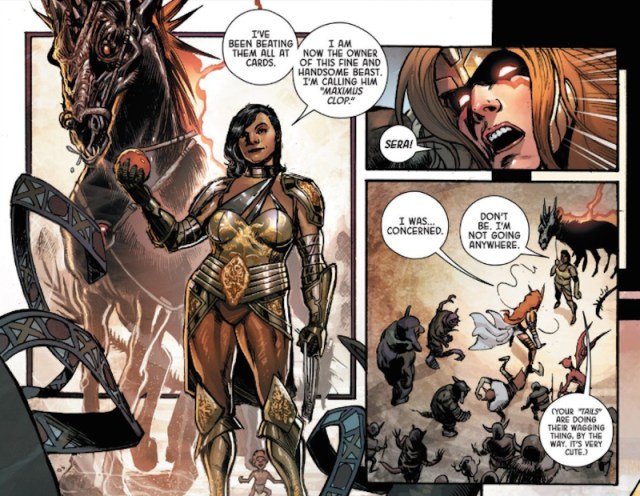
Sera talking to Angela. Art by Phil Jimenez
Also in February, Marvel Comics revealed that one of their characters was a trans woman. When Angela: Asgard’s Assassin #3, written by Kieron Gillen and Marguerite Bennett, and with art by Phil Jimenez and Stephanie Hans, shows the character Sera telling how she and Angela met, she explains that she was was born into the Anchorites, an all-male (except for the trans women who sometimes end up there) group from Heven, the home of the angels. One day she saw Angela come and slay a monster and she joined in and helped her. In return, Angela took her with her and Sera was free to be herself. As I said before, Sera, at this point, was the closest thing comics had to a trans superhero. In her current form, it looks like she might becoming the closest thing we have to a trans villain as well. Since then, Sera has again appeared as the second billed character in 1602: Witchhunter Angela and the current series Angela of Hel, where she and Angela shared not one, but two on-panel kisses.
One huge step for trans representation came in the form of Jem and the Holograms. In March, 2015, artist Sophie Campbell, who had been announced as the series’ artist, came out as a trans woman on twitter. Representation doesn’t just matter on the page, it also makes a big difference when you can see people behind the scenes who are like you. It helps you to see that you can do it too. For trans people everywhere, Campbell’s announcement was a big step in doing that. Not only is Campbell working behind the scenes as a trans woman, but she also created a new character for the series, Blaze, who she says is trans.

From Secret Six #4 with art by Ken Lashley and Tom Derenick.
Simone once again stepped up for her trans fans (and really, all of her fans), by introducing another trans character in her book Secret Six. Secret Six is about six strangers, some villains, some anti-heroes, some a little closer to heroes, who have been forced together and end up becoming sort of a chosen family. One of these characters is Porcelain, who has the power to make anything they touch turn hard and brittle. In Secret Six #4 (July 15, 2015) Porcelain, who had normally been presenting as fairly feminine, starts presenting in a more traditionally masculine way and explains to the team that some days they feel more like a man, some days they feel more like a woman. Once again, Simone wanted to make sure that all trans readers had someone they could look up to.
Porcelain identifies as non-binary, genderfluid. They’re another of my favorite characters, I love their sense of fun and showmanship. This again happened because there was a gap in representation. As more and more people come out as non-binary, it becomes clearer that the lack of characters who fit that description is quite glaring. So I asked of my readers who identify as such for help, and again, many, many readers were eager to help, which was lovely.
I was born on a farm, surrounded by rednecks. I’m still living in a small town with very little diversity. The willingness of readers to help is what has granted these characters whatever grace they have.
I really just want comics to be for everybody. There are a million comics out there with straight white casts and a hundred creators making more of them every day. I just think we can do better.
In my opinion, the three biggest moments in trans representation in comics are Rachel Pollack creating and writing Coagula, Alysia Yeoh coming out as trans, and this next moment. On August 26, 2015, Lumberjanes #17 came out and one of the main characters, a girl named Jo, came out as trans, making her the first trans protagonist of an all-ages comic, and perhaps the first trans protagonist of any mainstream comic. Lumberjanes is a very popular and very critically acclaimed series originally by Shannon Watters, Grace Ellis, Noelle Stevenson and Brooke A. Allen that’s won both Eisner and Harvey awards and sold over 65,000 copies of it’s first trade paperback in the first two months. This is a big moment. Not only is a popular comic, but it’s a very feminist one, and it’s all about girls being friends and going on adventures together.
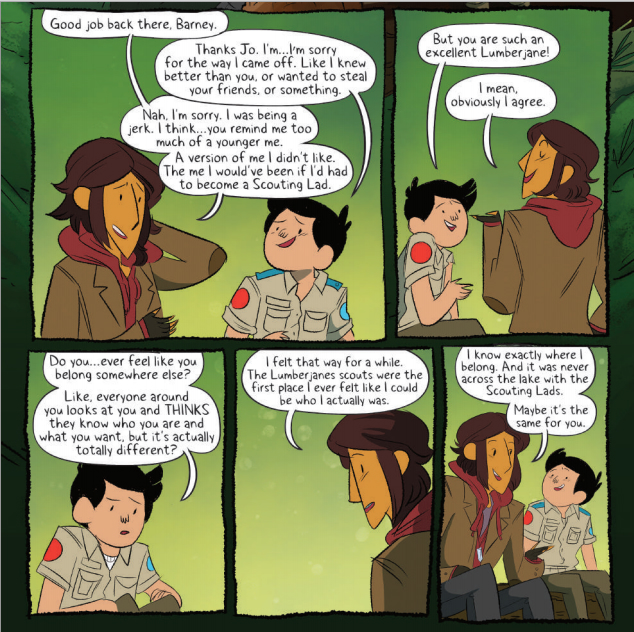
From Lumberjanes #17 with art by Brooke A. Allen.
Lumberjanes takes place at Miss Quinzella Thiskwin Penniquiqul Thistle Crumpet’s Camp for Hardcore Lady Types, where five girls — Jo, April, Molly, Mal and Ripley, and their counselor Jen — learn what it means to be friends and solve supernatural mysteries. And one of the girls that it includes is a trans girl of color. In Issue #17, Jo has a sit down with a boy from a nearby boy’s camp who’s been spending a lot of time with the Lumberjanes. She tells him that she’s been rude to him because he reminds her of a younger her, a version of her if she hadn’t been allowed to be who she is. She tells him that she found her place with the Lumberjanes and that if Barney ever feels like he doesn’t know where he belongs, he can be a Lumberjane too. It’s a very sweet moment, and a beautifully written and illustrated one (full disclosure: I consulted on the script for this issue), and it shows a trans character in a way that’s never happened in comics before.
Because this is an all-ages book, and because Jo is a real human girl who came out and transitioned like a real life trans person, Lumberjanes is doing something really special. They’re showing young trans kids everywhere that they belong, that they can be heroes, that they can find their place in the world. And they’re showing cis readers, hey, if the Lumberjanes are this welcoming and supportive towards trans girls, why can’t you be too? Watters, who co-created the Lumberjanes and co-wrote this issue and was also the editor for Help Us! Great Warrior, knows that representation is especially important in all-ages media.
Trans representation is so vital in all-ages media because the opportunity for trans youth to see themselves represented positively can literally be a life or death issue… so many queer kids struggle with the idea that they’re damaged because they fall outside of the “normal” that surrounds them in pop culture every single day. For some, that can be too much to bear. And what is “normal” if not seeing the deepest parts of yourself reflected honestly, and beloved? A character whose depiction reiterates the truth: you, like them, have value and worth. All-ages comics are accessible, and personal…easy to throw in a backpack or stash under a pillow, easy to read the pictures if not the words. Trans representation there can be held close, just for each and every trans kids to flip back to when they need it most, reiterated time after time. You have value, you have worth, you are loved. I hope in the future, more creators and publishers see that, and respond creatively.
So, Jo was trans when she first starred in Lumberjanes #1 back in April of 2014, making her the first trans character in an all-ages book, but since she didn’t come out as trans in the book until this summer, Leo from Help Us! Great Warrior was openly trans before her.
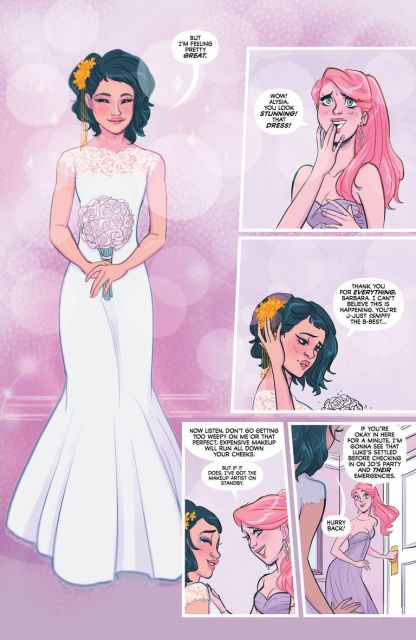
From Batgirl #45 with art by Babs Tarr.
Over at Batgirl, Stewart, Fletcher and Tarr started shuffling Alysia Yeoh back into the fold, even having her get married to her girlfriend, Jo, in an issue that was mostly about that wedding. Alysia announced her engagement to Jo in Batgirl #42 and then later rescued her from the claws of Velvet Tiger in issue #44, but it was Batgirl #45, released October, 28, 2015, where we got to a trans woman of color walk down the aisle and actually have a happy romance (something that Simone previewed in her alternate future story Batgirl: Future’s End #1). In both reality and the media we usually see trans women, especially trans women of color, being unable to find happiness and romance, so seeing Alysia, the first major trans character in a mainstream comic, smiling in a wedding dress was a big moment.
The Future
It’s extremely strange to see that the vast majority of actual trans representation — representation that doesn’t involve shapeshifters, body swaps, futuristic technology or magic — has happened since 2013. Now, of course, there are still some problems with transphobia and bad representation but those are becoming more and more rare. Instead, we get creators like Kelly Sue DeConnick saying she’s going to have trans characters in her Image comic Bitch Planet and artist Erika Henderson hinting at a trans character in The Unbeatable Squirrel Girl.
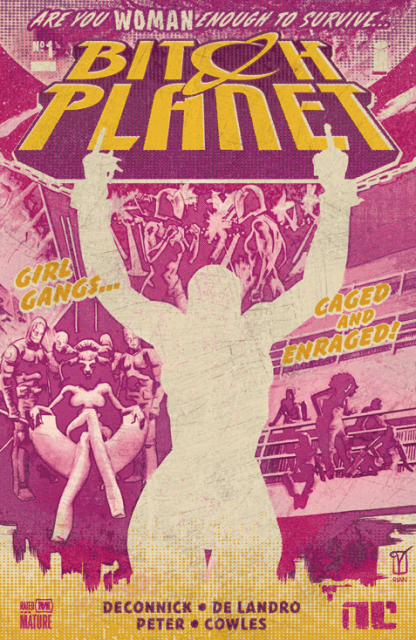
Bitch Planet #1 cover by Valentine De Landro.
As more and more trans characters are introduced into comics, the discussion is starting to shift from just the desire for representation, or even the desire for good representation to the desire for great representation. Who’s going to be the trans Wonder Woman, the trans Alana and Marko, the trans Ms. Marvel?
A few characters that are already appearing in comics feel like they could be that kind of character. Jo from Lumberjanes is a terrific character in one of the best all-ages comics around and Alysia Yeoh, who was never “just” a groundbreaking character, is a fan favorite with a ton of potential. But the next step is a trans character with their own solo title, a trans character who’s a clear standout in a team comic, a trans character who’s popular enough to get an action figure.
Another thing that the current Golden Age of Trans Comics is missing is someone who’s a true superhero. Sera comes close, so does Porcelain, but it’s going to be something else when we see a character who’s out there regularly fighting supervillains, hanging out with other super heroes and saving the day. It’ll also be amazing to see a trans supervillain, one who’s villainy has nothing to do with them being trans.
Comics also aren’t just about the actual comics anymore, they’ve permeated all of pop culture. Trans comic characters need to do the same thing. Currently there are five live-action TV shows from DC Comics (with another three coming out soon) and five more from Marvel (also with another three coming soon). Both companies also have several animated shows. With Marvel’s Jessica Jones, we’re finally seeing openly queer characters. Seeing trans characters make that same leap is one of the next logical steps in positive representation.
There’s also the ever-expanding world of comic book movies. Marvel and DC alone have over 25 movies planned over the next five years. However, seeing as only DC movie (Wonder Woman) and one Marvel movie (Captain Marvel) are starring women, it’s unlikely that a trans character will be introduced very soon. There’s still some hope for trans characters on TV and in movies, though, as The Wicked + The Divine has been picked up as a TV show and Lumberjanes has been optioned as a film.
Of course, another positive step that I’d love to see is more trans creators. Just like it’s impossible to know an accurate number of trans people in the general population, it’s impossible to know how many trans or gender non-conforming people are actually in the comics industry, but Sophie Campbell and Rachel Pollack are pretty much the two main names that are well-known, with others like Maddie Blaustein and Tamra Bonvillain also providing valuable additions to trans representation in comics.
We also need to see even more diversity. While it’s terrific that so many of the trans characters so far have been TWOC, there need to be more Black and Latina trans characters (these two groups of trans women are the most targeted group of trans people when it comes to anti-trans violence), more non-binary trans characters, more trans kids, more elderly trans characters, more trans men, some disabled trans characters, some fat trans characters.
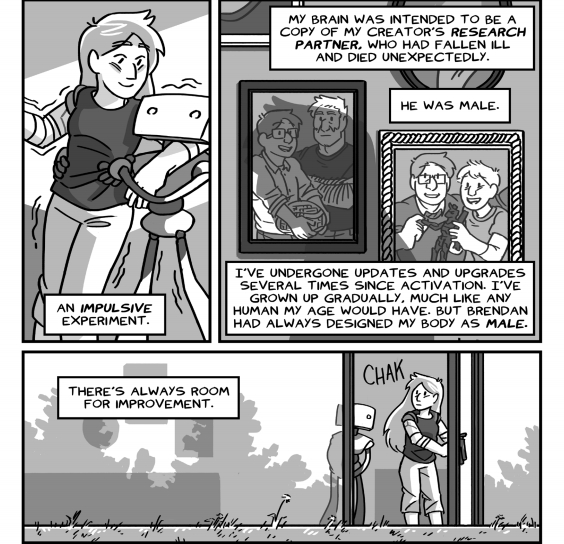
From “Optimal” by Blue Delliquanti in the Beyond Anthology.
When it comes to crowdfunded, online, small press or self-published comics, there’s much better representation. Sites like Kickstarter and IndieGoGo have helped facilitate the rise of a new generation of not only trans characters, but trans creators. Anthologies like Beyond, The Oath Anthology of New Heroes, Love in All Forms and Chainmail Bikini all were able to be published because of crowdfunding sites and all feature some terrific comics by and about trans people. These kind of comics are presenting an entirely new landscape in which we’re seeing a new kind of trans representation by the trans people, of the trans people and for the trans people.
The future is definitely a wonderful place. Rachel Pollack told me, “What’s happened in just the last couple of years is amazing and wonderful. I’m so excited to be around to see it and take part in it,” and I agree. On one hand we’ve got small presses and crowdfunding, which are giving trans creators more power and trans readers more access than they’ve ever had before. On the other, we’ve got indie and mainstream comics in the hands of writers, artists and editors like Shannon Waters, Sophie Campbell, Marguerite Bennett, Kieron Gillen, Kelly Sue DeConnick and Gail Simone who are making sure trans readers get the representation they deserve. If things continue to go the way they’re going, we’re sure to see not only the number of trans characters grow, but also the quality of their stories and personalities to grow. More and more writers are coming from a default starting position that includes trans characters. As DeConnick told me, the only reason she needed to include trans women in her feminist powerhouse comic Bitch Planet is “because they’re women.” Trans characters should be included in comics because because real life has trans people trans people are human and because trans people read comics. Most people who read comics are looking for a hero to look up to or a world they can escape into. Now that three dimensional, well-written trans characters are finally starting to appear in comics, trans readers everywhere can do that too.
Campaigns to Look Out For
In this section I’m going to highlight crowdfunding campaigns that you can support if you’re looking for more comics featuring positive representation for LGBTQ women.
Sophie Campbell’s Shadoweyes: Volume One Kickstarter is still going on for a little while longer. If you’d like to see this terrific comic from one of the best artists working in comics today, you still have a week and a half to do so.
Campaigners, by writer Brendan Hykes and artist MJ Barros, is set 50 years in the future when, instead of debates, Presidential candidates fight to the death to see who will lead America. A teenage girl named Kydra Franks stands up against the system and becomes a viral sensation. When her best friend, a trans girl named Bee, uses Kydra’s fame to find her own notoriety, all hell breaks loose. This project seems like it could be really cool and it needs a lot of support right now, so go check it out!
New Releases (November 18)
Jughead #2 (Archie Comics)
Adventure Time with Fionna and Cake Card Wars #5 (Boom!)
Lumberjanes #20 (Boom!)
Buffy the Vampire Slayer Season 10 #21 (Dark Horse)
Catwoman: A Celebration of 75 Years (DC)
Harley Quinn #22 (DC)
Secret Six #8 (DC)
Jem and the Holograms #9 (IDW)
Orphan Black: Helsinki #1 (IDW)
Phonogram The Immaterial Girl #4 (Image)
Pretty Deadly #6 (Image)
Rat Queens #13 (Image)
Shutter #17 (Image)
A-Force Volume 0: Warzones TPB (Marvel)
Captain Marvel and the Carol Corps TPB (Marvel)
Mighty Thor #1 (Marvel)
Ms. Marvel Vol. 4: Last Days TPB (Marvel)
Ms. Marvel #1 (Marvel)
Spider-Woman #1 (Marvel)
Star Wars #12 (Marvel)
Welcome to Drawn to Comics! From diary comics to superheroes, from webcomics to graphic novels – this is where we’ll be taking a look at comics by, featuring and for queer ladies. So whether you love to look at detailed personal accounts of other people’s lives, explore new and creative worlds, or you just love to see hot ladies in spandex, we’ve got something for you.
If you have a comic that you’d like to see me review, you can email me at mey [at] autostraddle [dot] com.
Pages: 1 2 3See entire article on one page



This was fascinating to read. Thanks for showing us how far we’ve come in terms of trans representation.
Mey, this is incredible.
Really satisfying to read through too!
Comics, especially away from the Big Two, are such an exciting place to be in the past few years: it’s a momentum, with a new generation of creators, that feels unstoppable.
And within the Big Two, the love and sincerity behind the epic fantasy-romance that Angela and Sera are shaping up to be is just extraordinary; and the tragedy, the ups and downs, the heart in your mouth genre drama and silliness, if you will, feels like something I can expansively embrace without the fear that who Sera is will be betrayed. Or that the relationship between these two women will be undersold. When you have to be so guarded in your life, it’s so nice to be able to just float in breathy-sighs and giggle a bit.
Wow. This is a masterwork, Mey!
This is so rad! I can’t wait to see the continuation!
Could I also recommend the comic Storm Dogs from Image, by David Hine and Doug Braithwaite?
http://www.bleedingcool.com/2013/05/08/gender-sex-work-and-going-beyond-diversity-natalie-reed-storm-dogs-5-print/
Oh, cool, i hadn’t heard about this and didn’t see anyone else talking about this as an example of trans representation. Thanks for pointing me toward it!
This is amazing! You’re so knowledgeable about comics, we’re all lucky to get to read your writing about them.
This is an awesome article, Mey! Thank you so much for the mention. :D One thing I was surprised wasn’t included: ‘Deathwish’ was created and written by Maddie Blaustein, a trans woman, who is sadly no longer with us. She was also the voice of Meowth from Pokemon!
Thanks! And Sophie, you’re totally right! I can’t believe I left her out! When I first came up with this idea and was making a list off the top of my head I thought “oh, i need to mention that woman who voiced Meowth” not being able to remember her name or what comic she wrote, but then when it came to actually write it, I somehow left her name off! I’ll add it in right now! Thanks
Fantastic, Mey!
Samuel Delaney’s takedown of that Sandman comic in his introduction to A Doll’s House is the most beautiful damning with faint praise I have ever read.
Nice overview Mey, you may also want to look at Welcome Back (issue #3 out this week) which features two soldiers who are reincarnated over and over into different bodies, both male and female. Also highly recommended is Flutter from 2013 about a girl with powers who meets a girl she likes and shape-changes into the girl’s ideal boy. It gets very complicated for her after that, but the first volume is very good. There is also a second volume that came out recently, but I haven’t read that yet.
For this week there are a few other comics with female or LGBT lead characters that everyone might be interested in.
– Clean Room #2 by Gail Simone. A woman is trying to bring down a self-help guru who she believes killed her fiance. Too early to tell how this one will turn out.
– Wayward #11. This is an interesting series set in Japan and delves into a lot of Japanese mythology. 5 teenagers with mystical powers are the lead characters and there have hints of romance between two of the girls.
– Vader Down #1. Marvel’s first Star Wars crossover as the rebels lead by Leia try to take out Vader while Aphra and her droid sidekicks try to rescue him.
– Cognetic #2. The lead character is a lesbian, although her wife and daughter have only been “seen” when she makes a phone call.
– Giant Days #8. I still have to catch up on this one, but I’ve heard it’s good.
– Welcome Back #3.
Here’s a site that lists more pre-2002 (last time the owner updated it) depictions in comics:
http://www.tgfa.org/
THIS RULES!! I was spoiled on Lumberjanes, but that’s okay and actually exciting because I was really hoping for a trans character in that comic and to have it be real just… jadlkfjghagh!! I can’t wait to catch up and then lend the new trade to my young friend (former nanny charge) who loved the first trade and wants to be a Lumberjane.
And wow. This is a masterwork. Thank you for all of your research and dedication! I’m now going to spend the remains of my snow day getting caught up on Lumberjanes, Shutter, and WicDiv.
Oh! And I was super thrilled to learn that Kate Godwin was named for Auntie Kate! What a great tribute to an incredible person!
This is a great article! I didn’t realise Jo from Lumberjanes was trans, and that’s good to hear – though I have to admit it really doesn’t interest me in going back to Lumberjanes.
I’d like to add a comic that’s missing from this, which is Gary Reed and Guy Davis’ excellent Baker Street, which has a trans main character. It’s a little… typical in what happens to her (I won’t say more), but I appreciated her being there all the same and it worked really well for the comic.
Thanks for letting me know about Baker Street!
Wow! Super informative and well written Mey! I learned a lot!
Thank you, Mey! This is wonderful. And I almost tweeted Kelly Sue DeConnick when I finished reading Bitch Planet, vol.1 to ask her if she was going to include trans women in future issues, but I kept going over the character limit in my tweets and gave up, haha. Happy to see I didn’t have to tweet her about it after all!
Wow. Wowowowow, Mey. This is incredible. I don’t even know that much about comics and I enjoyed reading this. In fact, it makes me want to read more comics…The Wicked & The Divine, in particular.
Thank you for this, it’s awesome!
Lord Fanny is a highly problematic character, but I’d categorize her as am actual trans woman. While it’s true her grandmother says she’ll raise the child as a woman to carry on the witch lineage, it’s not accurate to say she forces Fanny, either to be a girl or a witch. Throughout the issue on Fanny’s backstory, Fanny embraces and pursues feminine/witch expression/identity wholeheartedly and of her own volition.
There’s also a point later in the comic series where Morrison almost has Fanny say that genitals don’t determine gender, but he doesn’t commit and her line gets cut off by another character interrupting.
Batgirl and Bitch Planet have been on my to-get list and now I’m dying to read them ASAP! And Rat Queens! ACK!
This is awesome! Thanks for writing this, Mey!
I thought about chiming in with several recommendations for webcomics with trans characters (I’m a big webcomics reader), but now I’m hoping that will be another post…
Wow, some of these entries bring back dubious memories. Kudos on the incredibly comprehensive meta-analysis.
This history is perfect except for the fact that I’M not in it ^_____^
This misses out some 50s comics such as:
TRANSFORMATION
http://pappysgoldenage.blogspot.com.au/2009/10/number-606-no-longer-science-fiction.html
TRANSFORMATION COMPLETED
http://www.gayleague.com/comics-archives/transformation-completed/
also, in Gay Comix:
I’M ME!
http://imgur.com/a/a9koG#0
Fantastic list, thank you for putting it together. While there are certainly issues with Gaiman’s depiction of Wanda in The Sandman, I think some of the criticism is misdirected. Gaiman has stated quite clearly that the reason the Moon refuses to see Wanda as a woman was because he was specifically critiquing transphobia he’d observed in early 90s pagan communities. The effectiveness of that critique, or how it’s interpreted through a modern lens, well, that’s always up for debate.
Excellent!
Thanks for mentioning my Shining Knight. I let the Knight’s exact status remain vague, apart from their statement they were ‘both’, several other references to that effect, and my instructions to the artists, because I didn’t want to exclude *anyone* who identified as trans. It’s all there on the page, though, not something readers have to find in subtext. Good article. I loved Doom Patrol.
What a great article, I’m glad I took the time to read it. I’ve been mildly interested in Help Us! Great Warrior and now that I’ve been informed that there’s a trans woman in it I think I’m going to try it.
Fantastic article. One small quibble though. The picture of the Ultra Humanite that you have in the beginning of the article isn’t from Action Comics #20 nor is the art by. Joe Shuster. I have a scan of the actual page if you wish to use it.
Seems that you conveniently forgot that at the very end of “A Game of You” that Death sees Wanda completely as a woman. I remember Gaiman getting flak for how some random moon Goddess sees Wanda, Gaiman responded by saying that the way Death sees Wanda is what matters and that he agrees with Wanda about Gods and Goddesses sticking it up their sacred rectums. You also act like Gods and Goddesses matter in that series when it’s said over and over again that they only exist because we believed them into being, so how important is a God or Goddess if that is the case.
I also know that “A Game of You” was a catalyst for changing how comic readers saw trans people but I lament that they had to change artists halfway through and the new artist had no idea how to draw a trans person who had been on hormones for a long time.
Not sure if they count as Trans but the character Cloud (who was in reality a personified nebula with amnesia) from the Defenders in the late 80’s was able to manifest their physical form as both biological male and biological female.
Wonderful article!
Point of order though- that panel of the Ultra-Humanite was drawn by Kurt Shaffenburger, who drew Superman (and Superboy) for many decades, starting in the 1950s.
If you are looking for printing services in Ahmedabad, then look no further as we are here to help. Get in touch with us to know more about a wide range of printing services and prices.
Is there any chance of including Coagula from Doom Patrol (first introduced in 1993) by trans creator Rachel Pollack?
As far as I can tell she’s DC’s first actual trans superhero character (as opposed to shapeshifters, body-swaps etc.) and it would be good to see her represented.
Excellent post !
This is the best blog so far
This is best blog.
Skincell Pro is a powerful serum made from natural ingredients. With just a few drops applied to a blemish, the serum works to penetrate to the root of a mole or skin tag.